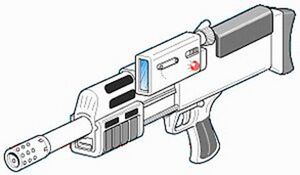VIPER-7
| Variable Impact Payload Enhanced Rifle (VIPER-7) | |
|---|---|
 | |
| Type | Payload Rifle |
| Place of origin | Kalaronian Republic |
| Service history | |
| In service | 2460–present |
| Wars | War of Cardassian Aggression
[[Tzenkethi War]] Dominion War Iconian War |
| Production history | |
| Designer | Kalaronian Interstellar Designs |
| Designed | 2325 |
| Manufacturer | Various |
| Produced | 2325–present |
| Variants | See Variants |
| Specifications | |
| Weight | 12 lbs |
| Length | 48 in stock extended |
| Barrel length | 16 inches(MGL) |
| Cartridge | 45×90mm grenade |
| Action | Double action |
| Rate of fire | 2 rounds/sec (MGL) (rapid fire) 12 rounds/min (sustained) |
| Muzzle velocity | 249 ft/s (MGL) |
| Effective firing range | 600m 1.3km (ERLP ammunition) |
| Maximum firing range | 3.5km |
| Feed system | Replication System |
| Sights | Collimator sight, Template:Tachyon Detection Array |
Overview
The VIPER-7 (Variable Impact Payload Enhanced Rifle) is an update of the earlier MYPR (Modular Yield Payload Rifle) system in use by the Federation, which itself had largely superseded the Foehammer Antimatter Projection Mortar used in the 23rd century. The MYPR and it's modification both share the purpose of providing Starfleet's Marine Forces with a variable effect heavy weapon, capable of being used in any number of roles, from pacification to lethal measures. An important part of their design criteria included reliable functionality regardless of the terrain or type of world a Starfleet member might find themselves under, such as worlds with lower gravities, sparse or dense atmospheres, ionic turbulence or disturbances, as well as the more typical environmental conditions such as windstorms.
Further, despite it's formidable reputation as a military weapon the VIPER is used by a number of Non-Starfleet organizations in the Federation, depending on their needs. Modified models are frequently made available for Science Missions, for instance, to serve as a deployment system anything from Sensor, Flares, Climatological and Ecology monitoring drones, or Fauna-Pacification devices when needed. Additionally, the sensor systems are often distributed without modification, meaning that covert observation of these missions -either by Orion Smugglers or Slavers, hostile forces from various Galactic States, or any number of different foreign interest groups- can often be detected and disrupted before it would prove to be a worse issue. This, as well as it's concurrent use in the Dominion War, helped to earn the device the nickname of the "Cerastes", after the eponymous Earth Legend.
History
The roots of the MYPR project stem from the brief but intense war between the Federation and the Klingons in the year 2270. With the collapse of the Treaty of Organia the previous year, Klingon forces under Commander Kor launched a surprise invasion of the Delta Triangle. This invasion relied upon a general call to war for the Klingon colonists that had -for a time- peaceably cohabitated that area of space. By utilizing the element of surprise, alongside a flotilla of merchant ships that had been converted to carry troops, Kor was able to establish beach-heads on several worlds -Holtzia, Gagarin, Sentinel, Khloral- before Starfleet had even become aware of the resumption of hostilities. Matters were further complicated by the generally lax security posture those worlds had taken, as they were ill-prepared for the savage manner of war the Colonists -many of whom had previously served in the Imperial Military of the Klingon Empire- brought with them. Records indicate that within three weeks, the populations of each world had been pacified, and large numbers of warriors had been recovered by their ships for subsequent invasions.
While Starfleet's response fleet (headed by the indomitable Enterprise) was able to restore the world